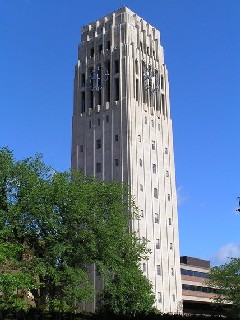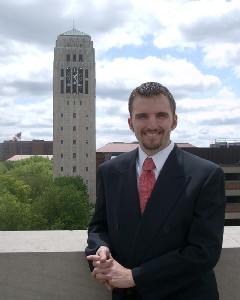
 |
The Baird Carillon is an instrument of fifty-five bells located in the Burton Tower on the University of Michigan campus at Ann Arbor. It was donated in 1936 by Charles Baird, a former athletic director at the University and an alumnus. It is an important Ann Arbor landmark.
Carillons are instruments consisting of at least two full octaves of bells (i.e. 24 bells in chromatic progression). The carillon is controlled by a keyboard of wooden levers and foot pedals which are played with the fists and the feet, respectively. Each lever connects to a hammer inside a bell. When the lever is depressed, the hammer strikes the bell and rings it. No computer technology or electricity is involved; carillons are fully mechanical. The carilloneur can play the levers in quick succession to form melodies, multiple levers can be pressed at the same time to form chords. Bells increase in size as they grow lower in pitch. In fact, every time the pitch descends five half-steps, the weight of the bell must double. The Baird Carillon's smallest bell weighs twenty-one pounds; its largest, a low E-flat, weighs 12 tons. The size of a carillon is determined by the cumulative weight of all its bells, and the Baird Carillon is tied for fourth largest in the world.
Carillons were invented in the 15th and 16th centuries in the Low Countries, or what is now Holland and Belgium (Burton Tower Webpage). The key to building carillons was the knowledge of how to tune a bell to play a certain note. A bell could only be tuned in a foundry after it was made; the founders would cast the bell slightly larger than necessary, then scrape out part of the inside of the bell to bring the pitch to the right value. It was a difficult process to figure out exactly how much metal to scrape out and where to scrape it from in order to tune a bell, bu the Dutch and Flemish founders were able to do it, and many carillons were built in Holland and Belgium (many of which are still operating today).
However, after the initial building boom, the secret of tuning bells was lost to the world. Throughout the nineteenth century, no carillons were built because no foundry knew how to do it. But in the early 1900s, the John Taylor Foundry of Loughborough, England, rediscovered the way to tune bells "by guess and check," in the words of Steven Ball, a modern carilloneur and carillon expert. The Baird Carillon was cast by the Taylor Foundry in 1936, one of the first carillons to be built in the United States, and one of the first to be cast in the new era of carillon-building.
 |
| Steven Ball and the Burton Tower |
Needless to say, the Baird Carillon is an important historical artifact. But it is also an important aspect of Ann Arbor's current, vibrant musical community. Carillon students at the University of Michigan have the chance to practice on it; guest performers are called in to perform on it during an annual series of summer concerts. Steven Ball, who is currently the graduate student instructor of carillon at the University, performs a short recital every weekday at noon. Any of these performances can be heard from anywhere within several blocks of the tower, and Mr. Ball usually leads a tour of the bells after each one.
A wide range of pieces can be heard on the bells. The musical selections are completely at the discretion of the performer, so one might hear anything from "Star Wars" to a Scarlatti sonata. Mr. Ball always tries to mix classical and popular pieces in his performances so as to engage a wide audience while presenting them with new music that they have not experienced before. The carillon students from the University study mainly classical music, but with such a wide pool of performers, the type of music performed varies significantly.
The Burton tower, which houses the carillon, is used by the School of Music of the University of Michigan. Most of the eight floors are taken up by classrooms and offices for professors and graduate student instructors, although there are also two practice carillons in the tower. The practice carillons do not actually contain any bells; instead, tuned strips of metal are hooked up to a carillon-style keyboard to provide a useful practice instrument that mimics a carillon. Also contained in the Burton Tower are the offices of the University Musical Society.
Steven Ball sees many exciting possibilities for the Baird Carillon in the future. Numerous concerts are planned for the coming year, and there are good possibilites for collaboration between the carillon and other community organization, including the Michigan Theater and the Top of the Park program. In any case, the carillon is a unique and important part of Ann Arbor's musical community, and it is unlikely that this will change in the near future.